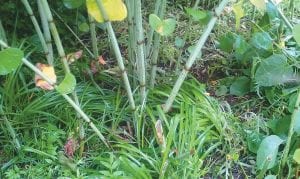Japanese knotweed such as this specimen on Cook County Road 8 may look delightfully exotic, but its presence poses a threat to both native plants and asphalt. Capable of reaching 10 feet in height and with roots 9 feet deep, the noxious weed is the latest invasive species to make its way to northern Minnesota and Cook County.

It’s official.
Invasive Species Coordinator Angelique Edgerton of the Cook County Invasive Team has confirmed the presence of Japanese knotweed in the county. A day after the Duluth News Tribune published an article about Japanese knotweed, Edgerton said she was contacted by a resident who thought she had some knotweed on her County Road 8 property.
“I went up to her place and found the plant, and sure enough, it is Japanese knotweed,” Edgerton said. “I think we have more of this around than we might realize, and I think people should be aware of the risks associated with some of these plants that may be growing in their yards.”
This plant is not regulated in Minnesota but is invasive and can spread and quickly colonize riparian areas. It can spread by seed, rhizome, or shoot fragments, and its roots and shoots can break through asphalt and concrete.
The County Road 8 reporting was the first in the county, said Edgerton. “It is in St. Louis and Lake counties but prior to this was not officially known in Cook County,” she added.
According to Edgerton, Japanese knotweed is a shrub-like perennial herbaceous plant that has smooth, hollow stems that grow annually to be over 10 feet tall. The plant identified in Cook County was about 10 feet in height. The roots can grow down to about 9 feet, one of the factors making this plant challenging to remove. The leaves are alternate, broad, and oval, and are quite large – around 6 inches long by 4 inches wide. It flowers in late summer (it has not flowered here yet this year) and produces green-white blossoms that grow in clusters. It reproduces by seed, root rhizome growth, and shoot or root fragment.
The plant is originally from Japan, where it is an early colonizer following volcanic eruptions and has evolved to break through volcanic rocks. Here, this is an issue because it can break through asphalt and concrete (including parts of your home, if it is adjacent). The plant can tolerate full shade and tends to grow in wet areas, which facilitates spreading through water.
One way for homeowners to treat it themselves is to cut and then apply a herbicide that contains glyphosate (such as Round up Concentrate Plus) immediately after cutting. You should not cut the plant with no follow up herbicide treatment as it will promote root growth and stimulate the plant to come back with more vigor.
For more information or to report a sighting of this noxious weed, contact Edgerton at (218) 387-3772.


Leave a Reply